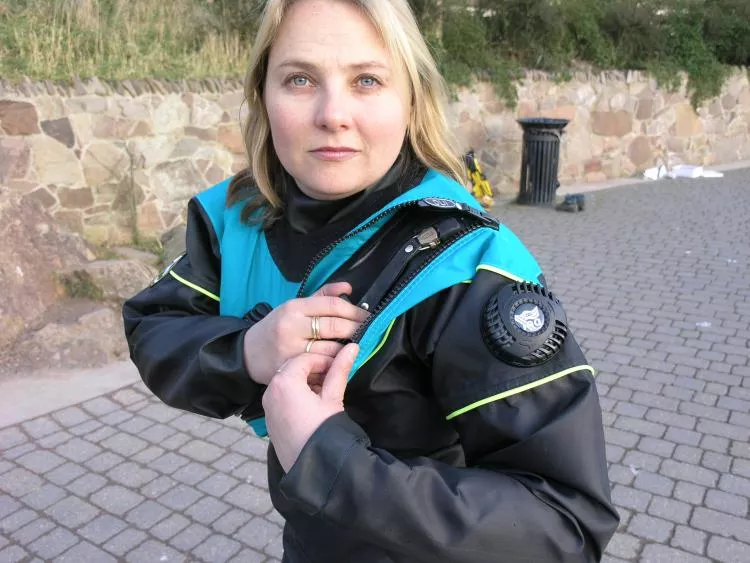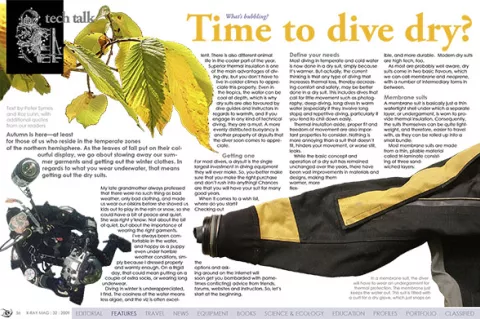Some of the Latest & Hottest in drysuits and undergarments
Contributed by
I’ve always been comfortable in the water, and happy as a puppy even under horrible weather conditions, simply because I dressed properly and warmly enough. On a frigid day, that could mean putting on a couple of extra socks, or wearing long underwear.
Diving in winter is underappreciated, I find. The coolness of the water means less algae, and the viz is often excellent. There is also different animal life in the cooler part of the year. Superior thermal insulation is one of the main advantages of diving dry, but you don’t have to live in colder climes to appreciate this property. Even in the tropics, the water can be cool at depth, which is why dry suits are also favoured by dive guides and instructors in regards to warmth, and if you engage in any kind of technical diving, they are a must. A more evenly distributed buoyancy is another property of drysuits that the diver soon comes to appreciate.
Getting one
For most divers, a drysuit is the single largest investment in diving equipment they will ever make. So, you better make sure that you make the right purchase and don’t rush into anything! Chances are that you will have your suit for many good years.
When it comes to a wish list, where do you start? Checking out the options and asking around on the internet will soon get you bombarded with (sometimes conflicting) advice from friends, forums, websites and instructors. So, let’s start at the beginning.

Define your needs
Most diving in temperate and cold water is now done in a dry suit, simply because it’s warmer. But actually, the current thinking is that any type of diving that increases thermal loss, thereby decreasing comfort and safety, may be better done in a dry suit. This includes dives that call for little movement such as photography, deep diving, long dives in warm water (especially if they involve long stops) and repetitive diving, particularly if you tend to chill down easily.
Thermal insulation aside, proper fit and freedom of movement are also important properties to consider. Nothing is more annoying than a suit that doesn’t fit, hinders your movement, or worse still, leaks.
While the basic concept and operation of a dry suit has remained unchanged over the years, there have been vast improvements in materials and designs, making them warmer, more flexible, and more durable. Modern dry suits are high tech, too.
As most are probably well aware, dry suits come in two basic flavours, which we can call membrane and neoprene, with a number of intermediary forms in between.
Membrane suits
A membrane suit is basically just a thin watertight shell under which a separate layer, or undergarment, is worn to provide thermal insulation. Consequently, the suits themselves can be quite lightweight, and therefore, easier to travel with, as they can be rolled up into a small bundle.
Most membrane suits are made from a thin, pliable material called tri-laminate consisting of three sandwiched layers: nylon as the inner lining, butyl rubber as the watertight membrane in the middle, and Cordura as the protective outer layer. This superbly flexible material is extensively used in drysuits, because it is quite resistant to abrasions, punctures and tears. It is also light, very flexible, requires little maintenance and is easy to patch and repair. Some suits also make good use of Kevlar—which is practically impenetrable—either just for patches on particularly exposed areas, such as the knees, or the whole suit can be covered by it.
Typically, technical divers will go for membrane suits, because they offer better freedom of movements, which, for example, is essential when you want to reach your gas valves behind your neck.
But as the suit itself offers the diver no thermal protection, a separate undergarment has to be worn. The diver has, of course, the option of varying their thermal protection according to the ambient water temperature at depth. The combined purchase of a membrane suit and a top-of-the-line undergarment will often be more expensive than buying a neoprene suit.
Neoprene suits
A traditional neoprene dry suit basically has just one main layer, which provides both thermal insulation and a watertight barrier. In its simplest form, it is essentially an upgraded wetsuit, equipped with various seals and a watertight zipper to keep water from entering, plus a couple of valves. This one-layer concept may provide a more affordable complete solution, but may also come with a number of drawbacks.
One, is the loss of insulation—and buoyancy—as the suit material compresses with depth, something every wetsuit diver is quite familiar with. The loss of insulation can be offset by wearing some sort of undergarment, but you still have the issue of marked buoyancy changes.
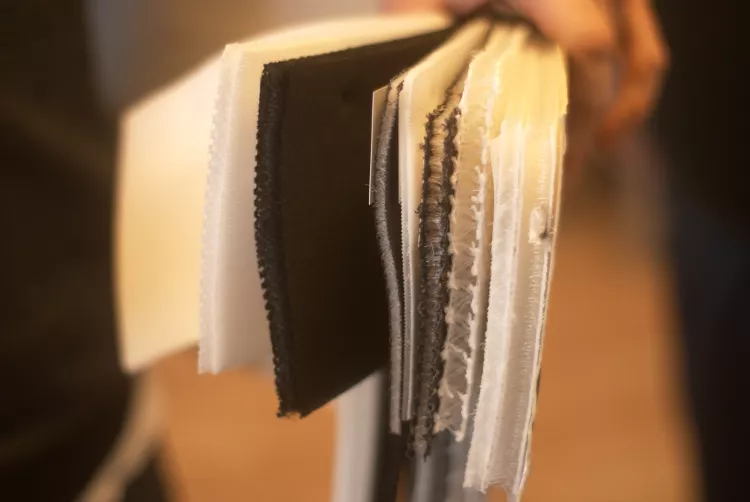
Crushed and compressed
Another option is going with more expensive materials such as compressed or crushed neoprene. The main idea of using these materials is that they don’t undergo the same degree of compression with depth, and as such, maintain the same level of insulation and buoyancy regardless of depth. In turn, that means that the diver will still need some extra layer of garment underneath for thermal protection, though much less than with a shell suit.
In many regards, suits of compressed or crushed neoprene can be regarded as hybrids, which combine the best of neoprene and membrane suits.
Crushed neoprene has the flexibility of a tri-laminate, the strength of neoprene, and the material stretches slightly. This means that the suit can be cut for a snugger fit without impairing the diver’s movement. The diver benefits from no inherent buoyancy changes whatsoever. This suit behaves exactly the same at 100 metres, as it does on the surface. Not unsurprisingly, these types of suits belong with those at the top of the range, both in terms of quality and price.
Design
The importance of finding a suit that both fits correctly and allows for plenty of freedom of movement cannot be emphasized enough. How flexible the suit is depends not only on which fabrics are used but also on how the material is cut and put together, just like other garments. Fortunately, we have seen much improvement in how suits are designed.
Biased cut is now being adopted by the pro-active manufacturers. Traditionally, fabrics were cut along the warp or weft. Now the manufacturers have discovered that if they cut the cloth on the diagonal to the warp and weft, (known as the bias), the fabric has a lot more natural stretch.
Tri-laminate suits that do not utilize the bias cut have less inherent stretch, so they tend to be cut on the generous side to allow the diver a full range of movement. They also are more baggy to allow for the undersuit, (providing the thermal protection). This can result in the diver suffering from drag, as they move through the water. Some membrane suits are also designed with telescoping torsos, which can make a huge difference when it comes to freedom of movement.
Fit
Neoprene suits have a snugger fit, because they are cut differently, as there is not such a need to wear so many thermal layers to keep the diver warm. Whilst the diver benefits from a sleeker fit, they can lose out in other ways. The snug fit makes it harder to don and reduces flexibility, impairing the diver’s movements. If you are thinking about moving into technical diving, this is not a suit for you. Gas shut downs can be a nightmare, or worse, impossible. Unfortunately, as neoprene ages, it becomes less flexible, worsening this problem. Another property, which is also lost as the fabric ages, is insulation.

Try it on!
Some manufactures offer made-to-fit, or bespoke, dry suits at a nominal extra charge. So, if any of their standard stock sizes do not fit you well, it will often be worth the extra expense to get it custom fit. In particular, you need to check if you can move your arms freely, and that you can reach the valves.
Does the suit allow you to stretch an arm without pulling on a sleeve and tugging on a wrist seal so it will let in water? Can you turn your head freely? And does it allow you to squat?
Often the standard across-the-shoulder configuration of the drysuit zipper will make it more difficult to reach behind your head.
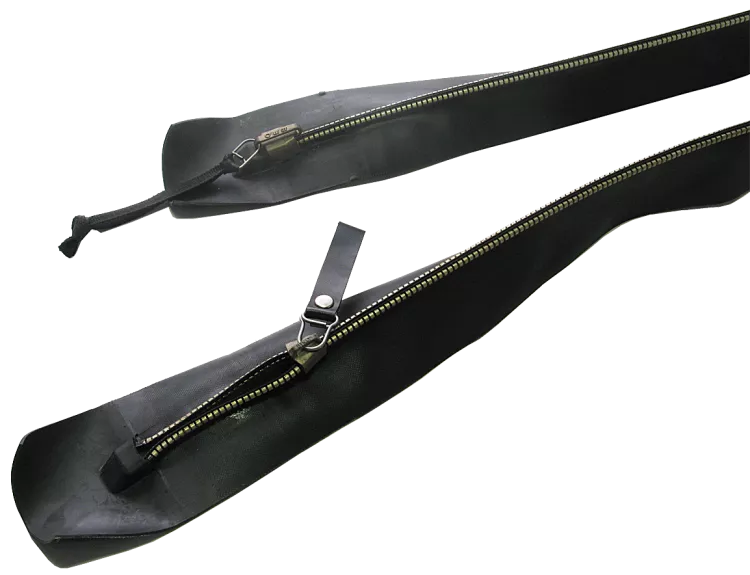
Zipper configuration
The standard arrangement is placing the zipper across the shoulders, as it is shown on the first page of this article. Here, it is less exposed to wear and tear, but unless the diver is a contortionist, the zipper is out of reach, so closing and opening the suit will require the assistance of a buddy.
In our recent survey, most divers stated that they preferred to be able to take their suit on and off without assistance. The two suits depicted on this page show two other zipper configurations: one that goes diagonally across the shoulders (center), and one that goes across the chest (right). These configurations are usually a bit pricier, but is often worth it.
The way the suit on the right is designed also provides for what is called a telescopic torso, which gives the diver more mobilty lengthwise. Other, but now mainly obsolete, ways of placing the zipper includes running it between the legs and around the head.
Since the zippers are exposed to wear and tear they will ultimately wear out and have to be replaced. The zippers are not cheap, which is why, on some models, the zipper sits protected under a flap or outer layer.
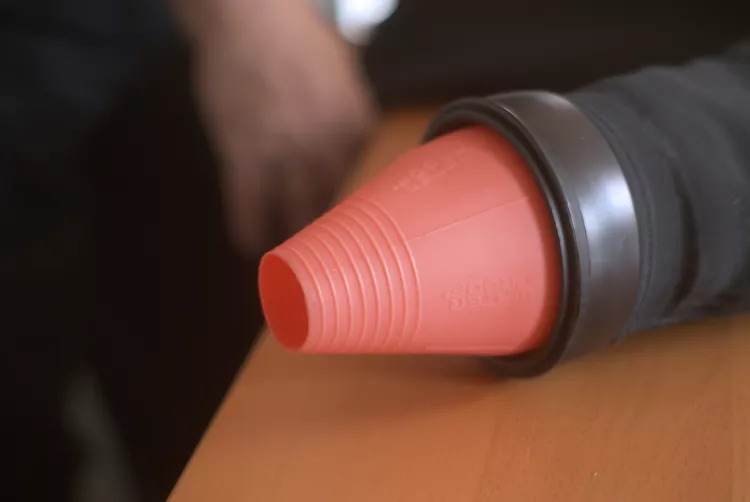
Seals
Latex or neoprene is the main choice though silicon has just been introduced as third alternative—good news for those who have a latex allergy. Latex has a snugger fit, but doesn’t insulate like neoprene, so the diver needs other thermal protection at least around the neck. Latex also tears easily—a careless diver with a sharp finger nail can poke right through the material. Neoprene seals are warmer, but fit less tightly, which may be an issue for some. A neoprene seal is to be folded back and tucked in, like an inverted turn-up, in order to seal properly.
Few items are as useless as a drysuit with a torn seal. Often, it can only be fixed by a trip back to the repair shop for a replacement, but there are also options around that enable divers to change seals themselves—something that could save a weekend. Some user-replacable neck seals are shown on page 67.
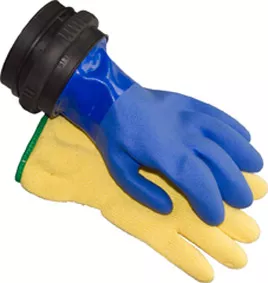
Dry gloves
If you are diving in cold water, there is no way around dry gloves. A number of brands have marketed various designs over the years, but they are all variations of the same basic theme in which a two-part locking system forms a watertight seal between the glove and sleeve. Some of the designs work using friction where the diver just squeezes the glove onto some sealing o-rings, while others have twisting rings that lock and/or unlock the glove.
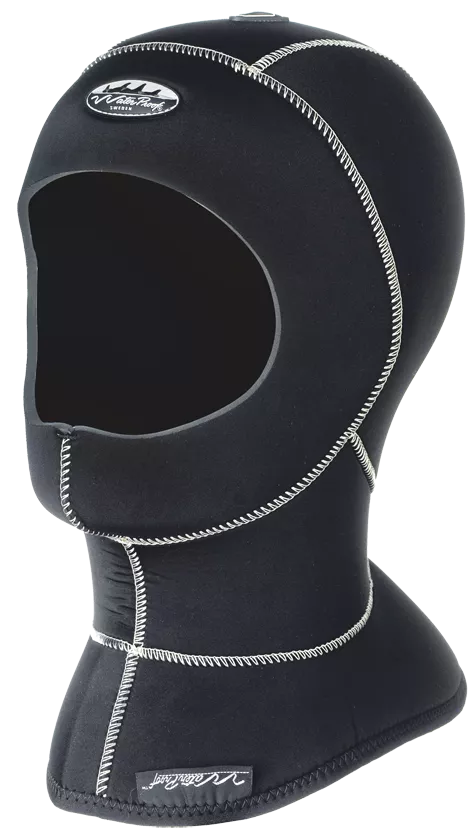
Hoods
Using loose hoods seems be gaining popularity, and not without reason, as one can essentially find the hood that suits one best. Also a seperate hood makes it more comfortable to wear the drysuit between dives i.e. while underway to a dive site.
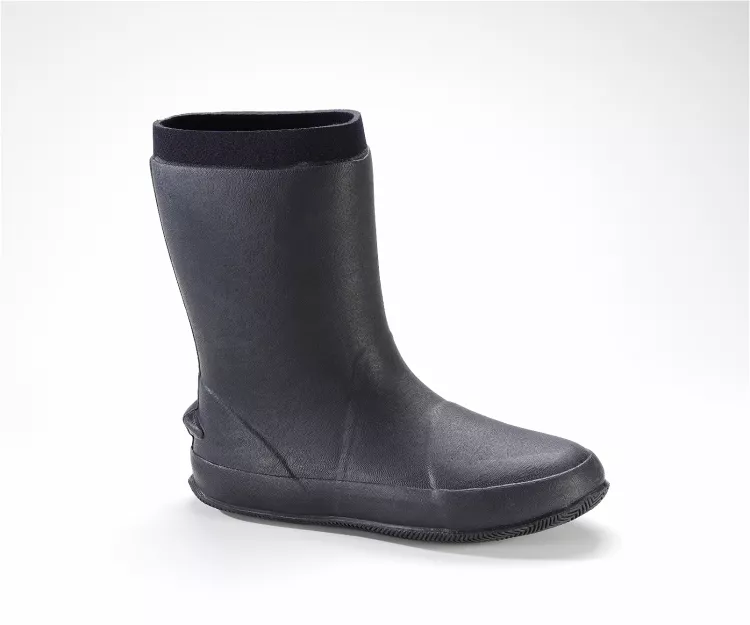
Boots
The vast majority of suits have built-in boots, though it is possible to opt for good ankle seals instead. Some of the manufacturers will give you a choice of boot, and again, wear your thickest thermal protection to help get it right. It’s not really worth going for boots with thin soles. Although they are light, you do get to experience the “ooh-aarrhh-ouch” factor in its full glory, as you trog over rocky shores and stones. Neoprene lined boots are warm and snug, so this can mean you have to go up a size, but all in all. these are a popular choice. For those of you who teach on a commercial basis, heavy duty boots, especially heavy duty boots with a heel, are worth considering. Commercial divers are catered for with heavy duty steel boots complete with steel soles and toecaps.
And then you have DUI. They have always done things differently, and until recently, I really hated their boots because they were effectively socks with a sole glued to the bottom. Horribly flappy things, and it was this one feature that really put me off buying one of their suits. Happily, this all changed with the advent of the Rock Boot. These days the diver still has a “sock” on the end of their suit, but they now don a pair of rugged boots to dive in. A boon for divers who walk and climb to sites.
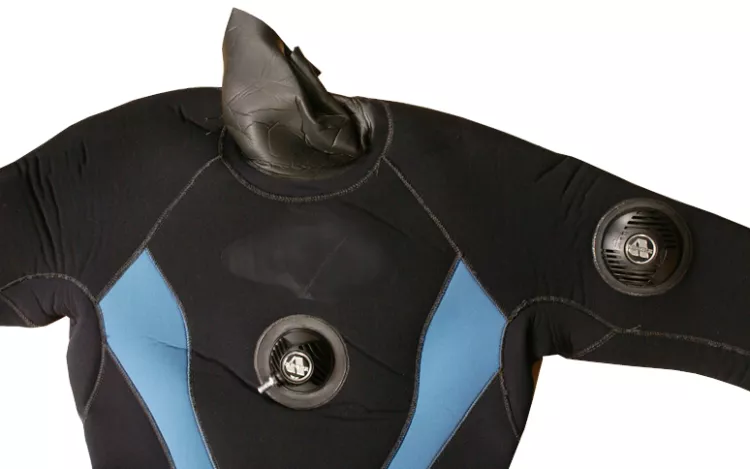
Valves
Most suits are already fitted with valves, so most of the time, you don’t really have an option of choosing. Inflators and suit dump valves are dominated by two manufacturers: SI-Tech and Apeks, which over the years have constantly strived to design more streamlined products with low profile.
A good inflator valve should be able to swivel in full circle, so you can route your inflator house any way you want. Your dumps and inflators should be of the same brand, as the two products have been designed and tested to work together.
The inflate button on my suit can be difficult to find within the large inflator assembly. Having a raised, or otherwise obvious, inflator button would be nice, especially because thick gloves are used, and hands are sometimes too numb to feel the button accurately.
When it comes to dumps, there are two main types—shoulder dumps and cuff dumps—though the latter seems to be going out of fashion. A cuff dump is automatic and idiot proof, and approximately the size of a small marmalade lid. A cuff dump is normally located on the left hand arm, above the wrist seal. To vent air, the diver just raises their left hand. This can cause problems with involuntarily dumping of air when teaching, photographing, deploying a surface marker buoy, or hanging onto a shot line.
A cuff dump also means that you might not be able to have a computer on that wrist, as it will impair air flow. That said, this is a good option for new divers, because it is so simple to use.
I prefer a shoulder dump. It’s adjustable. By turning the dump valve, you can control the degree by which the air is vented off. This means that I can screw it down to stop gas escaping, if I have a very long decompression stop. It can be set to automatic, so as you rise, the air inside the suit expands and thus escapes through the dump. Alternatively, you can hold the dump down to allow more air to escape.
Gaiters or ankle weights
Ankle weights are en easy way to distribute weight more evenly along your body and help keep your feet down, if you have a tendency to have floaty legs. If you don’t like finning with added weight around your ankles, gaiters, which wrap around your shins, may be the solution for you.
P-valves and zippers
Sorry, gals, these inventions just cater to men’s needs. A p-zipper, like the one depicted below, allow the gent with an urgent need to perform his business without having to get out of his suit. These extras are a bit on the pricey side and constitute an added point of failure, so why not just make it a habit to go to the men’s room in a timely fashion?
A P-valve is a device for technical divers allowing the diver to urinate into the water at depth by the means of a condom-like attachment and hose that passes through the suit.
Pockets
Pockets are invaluable for stashing all sorts of things such as a spare mask, D-SMB (Delayed Surface Marker Buoy), a reel, a slate, and a backup torch.
Placing cargo pockets on the front thigh seems a good idea, but positioning them on the side is often a better option. There is less in-water drag, as the pockets are in the slipstream of your shoulders, whilst giving easy access to the contents.
This is something you need to keep in mind should you start using side-mounted stage cylinders. When you are diving with a stage, accessing a front cargo pocket for your D-SMB is a bit tricky.
Front-mounted cargo pockets can also get in the way when you are rib diving, as they tend to catch when climbing back into the boat.
When you stand with your arms by your sides, the bottom of the pocket should be placed in line with the ends of your fingers, whilst being sufficiently above the knee, so that the pocket doesn’t get in the way of your finning.
s for fastening your pocket, one camp advocates that cargo pockets should be zipped up, so that items don’t fall out. Others say that Velcro is best for easy access, arguing that zips may jam when you least want them to. Drain holes are a must, and it’s a sensible idea to have a method of attaching things to prevent everything from falling out. Bungee is a popular choice. It allows you to pull out the entire contents of your pocket, grab what you want, and replace the remainder.
A bungee loop is better than a clip, as you can always cut a piece of bungee should it get tangled.
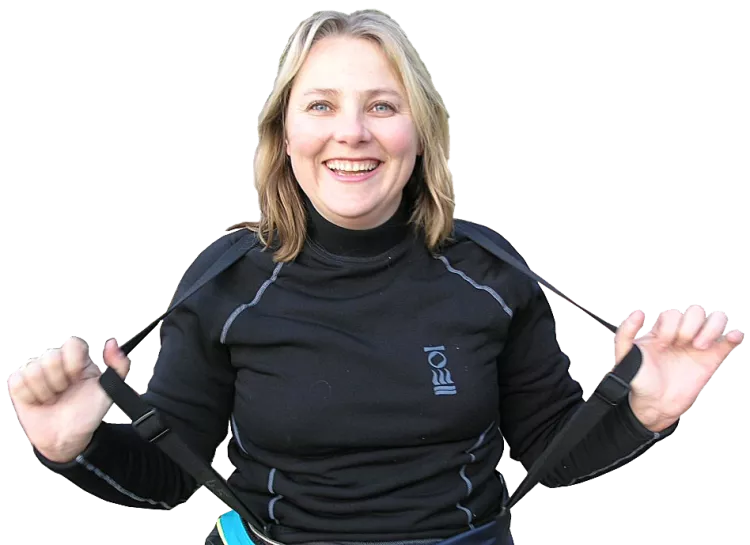
Brace yourself
If your suit does not come with braces, or suspenders, go and get yourself a ‘Fit your own braces’ Aqua Pack. Braces also allow you to wear your suit partially donned without you having to clutch great armfuls of suit. If you are not careful, you can damage your zip should you wear your suit half donned.
With a front donning diagonal entry suit, it is better for the suit if you wear it either fully on, or take it off. If you wish to wear it half donned between dives, then take time to pull the arms through the braces to take the weight of the suit, or knot the arms around your waist. If you let the full weight of the suit hang down on the braces, over time, the zip can suffer unnecessary strain because it is bouncing on the braces, and it will bend and flex. A front-donning suit zip can last longer than a back entry zip provided you don’t go around with the suit open, folded back, and hanging on the braces. ■
Published in
- Log in to post comments



